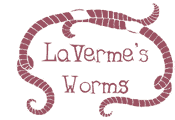 |
 |
|
ellensandbeck.com Green Barbarians–Ellen Sandbeck  A Buddha A Day–Ellen Sandbeck  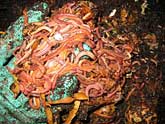 |
Worm Wranglers
Ellen and Walter Sandbeck are picky about their worms. "Not just any worms work for composting", says Ellen. "The ones that are
hearty outside are not good with compost, and the ones good with compost are not much good outside." Multiply fast "If you started a bin of worms today, with their
exponential growth, you’d have worms to sell
in six to nine months," says Ellen. Worms mate
twice a week and produce one worm per egg case. Those two new worms will lay an egg case several days later. "After a couple of months, there’s your
population explosion," says Ellen. Midwest, but they have sold worms from Colorado to California. "The worms need to be delivered in one day in a gallon container of medium or they are not happy!" says Ellen. They sell worms to households, schools, prisons, and to people on acreages with big gardens. Some of the schools use stock tanks covered with tarps. Big bins full of worms can handle a lot of compost material, says Ellen. Worm castings are concentrated. "You can’t put worm compost on legumes," says Ellen. "It’s too rich for them; they will make leaves and no peas or beans. It should be used only on plants that like to be fertilized, such as corn, squash, basil, tomatoes, or roses." On their acreage, the Sandbecks use 150-gallon plastic stock tubs. Their tanks are so large they can throw in 5-gallon buckets of compost with no problem. They keep bags of composting leaves on hand to feed the worm bins. "Cemeteries are great places to get good, clean leaves," says Ellen. "There are no dog droppings, no trash, and the leaves are always very clean."
Ellen tells the story of a friend who was bringing home a 5-gallon bucket of worm juice to use on her garden. "She needed the bucket badly for another purpose right away, so she poured the whole works out in the gravel driveway. The next spring, a big patch of clover grew in that over-fertilized spot in the middle of the driveway," she says. "You could probably grow things in concrete with this stuff!" Getting started
The Sandbecks sell bins (27-gallon bin is $175), worms
(starter kit with 1/2 pound of red wriggler worms is $38)
worm juice (32 ounces for $10), and more. Ellen has used
her experiences, both good and bad, to write books on
worming and composting. including Laverme’s Handbook
of Indoor Worm Composting ($6 on lavermesworms.com),
Organic Housekeeping ($19.80 on mazon.com), Eat More
Dirt ($11.25 on Amazon), and SlugBread and Beheaded
|
|
|
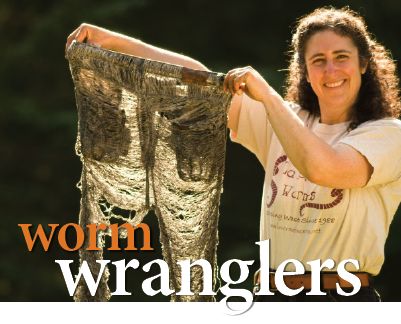 This Minnesota couple uses
This Minnesota couple uses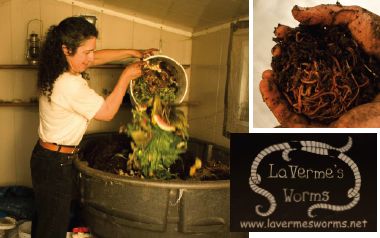 The worms self-regulate their population in a bin, so you never get too many, she says. If you remove a bunch of worms to start a new bin, the worms will repopulate.
The worms self-regulate their population in a bin, so you never get too many, she says. If you remove a bunch of worms to start a new bin, the worms will repopulate. 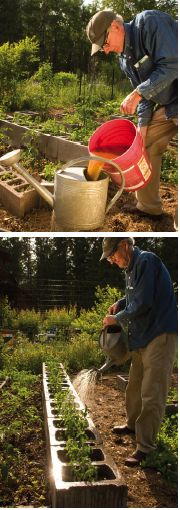 Worm juice
Worm juice, another byproduct of raising a bin
of worms, is the liquid excreted out the bottom
of a bin’s spigot, and is a concentrated fertilizer
similar to manure tea. It’s a potent product that
needs to be cut with water about 20-1 to give
plants a feeding boost. Ellen and Walter’s bins
have a special membrane that keeps the worm
medium up off the bottom of the bin, allowing
for air flow and drainage of the worm juice. "You can make a worm-raising bin out of just about anything," says Walter. "Old coolers are
pretty good. You can make your bottom filter out out of the liquid, such as landscape fabric."
Worm juice
Worm juice, another byproduct of raising a bin
of worms, is the liquid excreted out the bottom
of a bin’s spigot, and is a concentrated fertilizer
similar to manure tea. It’s a potent product that
needs to be cut with water about 20-1 to give
plants a feeding boost. Ellen and Walter’s bins
have a special membrane that keeps the worm
medium up off the bottom of the bin, allowing
for air flow and drainage of the worm juice. "You can make a worm-raising bin out of just about anything," says Walter. "Old coolers are
pretty good. You can make your bottom filter out out of the liquid, such as landscape fabric."